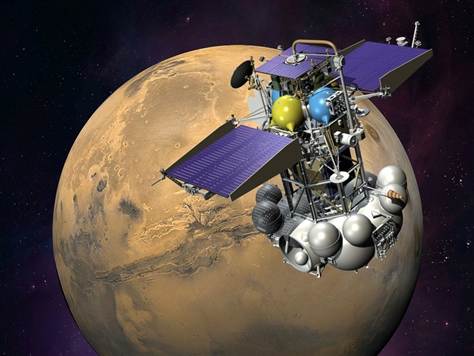Two weeks ago, panic engulfed the Russian space agency after one of its dearest project, the $170 million Phobos-Grunt mission, which was set to land on Mars’ moon Phobos, collect samples and then return to moon, got stranded in orbit, completely blocked off from any kind of communication. Valiant efforts were made to restore the craft, but in vain. However, just recently, an Australian ground station has managed to establish contact with the probe, fueling hope for a possible salvaging.
Before the disastrous Nov. 9 launch from Russia’s favorite pad site, the Baikonur Cosmodrome in Kazakhstan, the Phobos probe was herald as a symbol of the nation’s interplanetery ambitions. When the probe eventually reached Earth’s orbit, however, engineers couldn’t fire its engines which should’ve propelled the craft in its months long voyage towards the red planet – they couldn’t even establish a com-link for that matter. Along with the Phobos craft, was China’s first interplanetary probe, Yinghuo 1, which piggy-bagged along with the Russian drone for a supposed drop off in Martian orbit – it too, of course, failed.
A glimmer of hope has risen recently after ESA’s tracking station in Perth, Australia, made contact with the probe late Tuesday. Before this event, Vitaly Davydov, Russia’s deputy space chief, was quoted as saying “chances to accomplish the mission are very slim.” Expect to add at least a notch to those chances, now.
Currently, the Russian space agency is hard at work trying to kick-start the probe again, in cooperation with ESA and NASA, and have been doing so for the past two weeks, for that matter. To problem is, even with a firm re-establishment of contact with the Phobos-Grunt, its engineers can only do so much. If the problem is indeed related to a software issue, they might have a chance, however some experts believe the the failure was rooted in the hardware, which in space is impossible to fix.
Davydov said that if engineers can’t take control of the spacecraft, it could crash to Earth sometime between late December and late February. It’s trajectory can’t be calculated earlier than a day in advance. People should not worry, though, says Davydov, who claims the probability of the probe hitting a human being is virtually nil. This person was part of the 0.000001%.
There is one good thing that might come off this disaster – a tighter international collaboration for missions in the future. Seems like this huge setback for the Russian interplanetary program could motivate the country to accept the issued invitation to join U.S.-European space missions to Mars. The ExoMars Trace Gas Orbiter mission will launched in 2016 for a scheduled arrival at Mars nine months later. The mission will test out the technology necessary for entry, descent and landing for future, possibly manned, missions to Mars.
More updates on the events following the Phobos probe will be posted as soon as they reach our ears.










